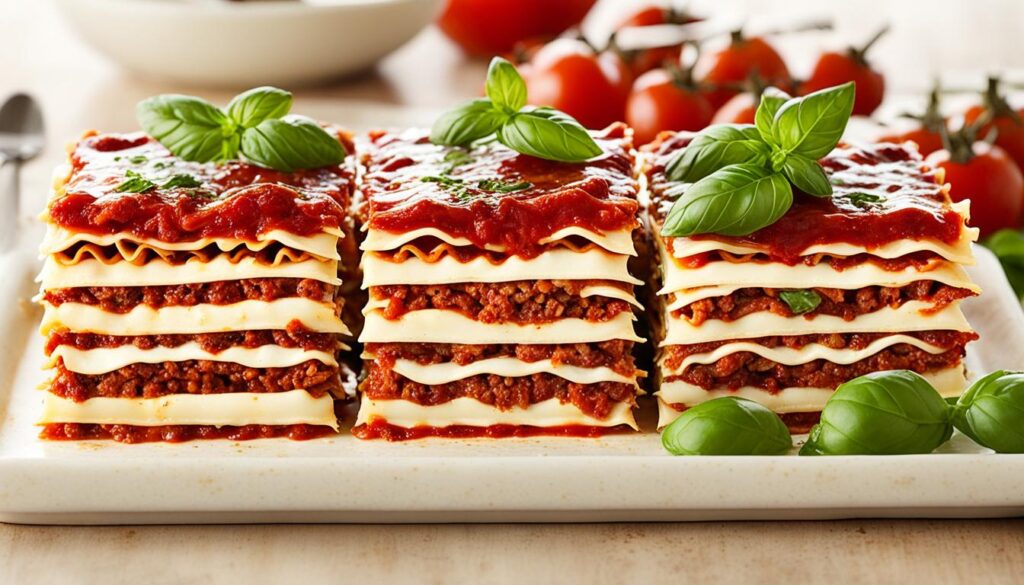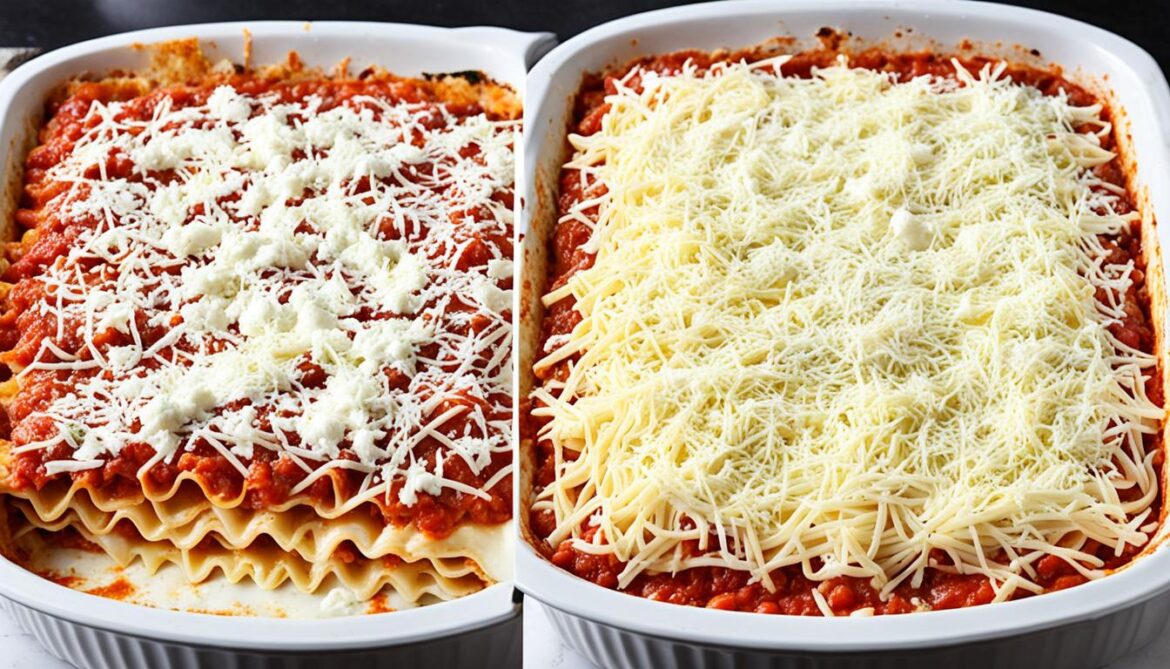Lasagna layering can sometimes be a confusing process, but with the right guidance, you can achieve a perfect lasagna every time. By following a proper order for the noodles, sauce, and cheese, you can create a beautifully layered lasagna that is both delicious and visually appealing.
Key Takeaways:
- Start with a thin layer of sauce on the bottom of the baking dish to prevent sticking.
- Layer the components in the proper order: noodles, ricotta cheese, other fillings, and more sauce.
- Finish with a final layer of pasta, sauce, and shredded cheese for a golden-brown crust.
- Bake the lasagna until heated through, cooked, and the cheese is browned and bubbling.
- Let the lasagna rest before slicing to allow the layers to set and flavors to meld.
Start with Sauce
The first step in perfect lasagna layering is to start with sauce. Whether you’re using a tomato-based sauce or a meat sauce, spreading a thin layer of sauce on the bottom of the baking dish is essential for a successful lasagna. Not only does it prevent the noodles from sticking to the dish, but it also adds flavor and moisture to each layer.
To ensure even distribution, use the back of a spoon to spread the sauce in a thin and even layer. This will create a solid base for the other ingredients and make it easier to slice and serve the lasagna once it’s baked.
Here are a few lasagna layering instructions to keep in mind when adding the sauce:
- Start with a thin layer of sauce at the bottom of the baking dish.
- Spread the sauce evenly using the back of a spoon.
- Make sure the entire bottom of the dish is covered with sauce.
By starting with sauce, you set the foundation for a well-layered lasagna that will impress both your taste buds and your guests. Once the sauce is in place, you can move on to the next step in the lasagna layering process.
Add the Middle Layers in the Proper Order
After adding the sauce, it’s important to layer the other components in the proper order. This step is crucial to ensure a perfectly assembled lasagna. Follow these professional lasagna layering techniques for a delicious and visually appealing dish.
Layering Technique:
- Start with a layer of lasagna noodles. Make sure to overlap them slightly to cover the entire surface of the dish.
- Next, spread half of the ricotta cheese (or béchamel sauce) evenly over the noodles. This creamy layer adds richness and moisture to the lasagna.
- Add half of any other fillings you desire, such as roasted vegetables, cooked ground meat, or sautéed mushrooms. Distribute them evenly to ensure every bite is flavorful.
- Top the filling with another layer of sauce. This helps bind the ingredients together and adds an extra burst of flavor.
- Repeat the sequence of noodles, ricotta cheese, fillings, and sauce to create two layers in the middle of the lasagna. This layering technique ensures even distribution of flavors throughout the dish.
By following these lasagna layering techniques, you can create a professional lasagna with perfectly balanced flavors and textures. The layers of noodles, cheese, and fillings will come together harmoniously, resulting in a mouthwatering lasagna that will impress your family and friends.
The Final Layer
When it comes to the final layer of your lasagna, there are a few key tips to keep in mind for a mouthwatering and perfectly assembled dish. This layer is your opportunity to create a stunning golden-brown crust on top, as well as add an extra punch of cheesy goodness.
To start, lay down a layer of cooked pasta sheets. Choose your favorite type of lasagna noodles, whether it’s traditional, whole wheat, or gluten-free. Ensure that the noodles are cooked to al dente, as they will continue to cook while baking.
Next, generously spread your favorite sauce over the pasta. Whether you prefer a classic marinara, a meaty bolognese, or a flavorful white sauce, the choice is yours. The sauce adds moisture and richness to the lasagna, creating a delicious base for the final layer.
Now, it’s time for cheese! For the ultimate indulgence, use a combination of shredded mozzarella and Parmesan cheese. The mozzarella adds a stretchy, gooey texture, while the Parmesan brings a distinct nutty flavor. Sprinkle the cheese evenly over the sauce, covering the entire layer.
Pro tip: To enhance the flavor profile, consider adding a sprinkle of dried herbs like basil or oregano, or even a dash of red pepper flakes for a hint of spice.
Now that you’ve assembled the final layer, it’s time to pop your lasagna into the oven and let the magic happen. Bake according to your recipe’s instructions until the cheese is melted and bubbling, and the top is beautifully browned.
As promised, here’s a visual representation of the lasagna layering process:
| Layer | Ingredient |
|---|---|
| 1 | Pasta Sheets |
| 2 | Sauce |
| 3 | Cheese (Mozzarella and Parmesan) |
This table summarizes the components of your final lasagna layer. Remember to repeat these steps to create additional layers if desired, ensuring that your lasagna is well-balanced and tastes incredible from top to bottom.
How to Bake Lasagna
The baking time and temperature for lasagna can vary depending on the type of lasagna and noodles used. To achieve a perfect lasagna, it’s crucial to follow the correct baking instructions. Here are some general guidelines to help you create a delicious and perfectly baked lasagna:
- Preheat your oven: Before baking your lasagna, preheat your oven to the recommended temperature stated in your recipe. This ensures that your lasagna cooks evenly and thoroughly.
- Cover with foil: To prevent the top layer of cheese from burning, cover your lasagna with aluminum foil for the first portion of the baking time. This helps to trap moisture and create a steamy environment for the lasagna to cook.
- Bake until heated through: Bake your lasagna until it is heated through and the components are fully cooked. Test the doneness by inserting a knife into the center of the lasagna and checking that it comes out hot.
- Uncover and brown the top: Towards the end of the baking time, remove the foil to allow the top layer of the lasagna to brown. This results in a beautiful golden crust and adds texture and flavor to your dish.
- Check for bubbling cheese: To ensure that your lasagna is fully baked, check for bubbling and melted cheese on top. This indicates that the cheese has melted and the lasagna is ready to be removed from the oven.
Remember, these are general guidelines, and it’s important to follow the specific instructions provided in your lasagna recipe. By following the proper baking time and technique, you’ll achieve a perfectly baked lasagna that will be the star of your meal.

Conclusion
Layering lasagna may seem intimidating, but with the right techniques, you can create a beautifully layered lasagna that is not only visually appealing but also delicious. By following the proper order of ingredients, starting with sauce, and building layers with noodles, cheese, and fillings, you can assemble the perfect lasagna every time.
To achieve the best results, remember to season each layer with herbs and spices that complement your chosen sauce and fillings. This will enhance the overall flavor profile of your lasagna. Additionally, allowing the lasagna to rest for a few minutes before slicing and serving will help the layers set and make it easier to cut and serve.
Impress your family and friends with your lasagna layering skills, using this tutorial as your guide. Whether you prefer a classic tomato-based sauce or want to explore more creative options, the key is to create a balance between the sauce, noodles, cheese, and fillings. With a little practice and these lasagna layering tips, you’ll be able to assemble a lasagna that is both visually stunning and incredibly delicious.
FAQ
How do I start layering lasagna?
Start with a thin layer of sauce on the bottom of the baking dish to prevent the noodles from sticking and make it easier to slice and serve the lasagna.
In what order should I add the middle layers of lasagna?
Start with a layer of lasagna noodles, followed by half of the ricotta cheese (or béchamel sauce) and half of any other fillings, such as roasted vegetables. Then, add more sauce and repeat this sequence to create two layers of noodles, ricotta, and fillings in the middle of the lasagna.
What should the final layer of lasagna consist of?
The final layer should consist of a layer of pasta topped with sauce and shredded cheese, such as a mix of shredded mozzarella and Parmesan cheese, for a deliciously cheesy and flavorful final layer.
How do I bake lasagna?
Bake the lasagna until it’s heated through, the raw components are cooked, and the cheese on top is browned and bubbling. Follow the specific instructions provided in your lasagna recipe for the best results.







